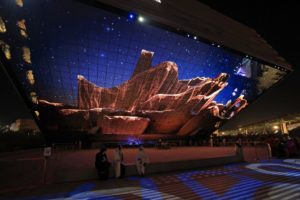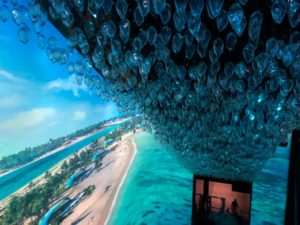São Paulo – An inclined, mirrored rectangle like a spacecraft ready to fly. Saudi Arabia pavilion stands out among the pavilions of the 191 other countries at Expo 2020 Dubai, United Arab Emirates. A mirrored screen outside is 1,320 square meter. Inside, five levels show the culture and heritage of the country, its natural landscapes, its developments, and future ambitions. The idea of the pavilion is being “the country’s window to the world,” showcasing Saudi Arabia as a tourist and investment destination and attracting people to visit and establish business there.

People, Heritage, Nature and Opportunity are the four major pillars of the pavilion. On this tour, visitors can get to know more about the kingdom and learn about its culture, heritage, natural diversity, and investment opportunities.
The state-of-the-art building combines architecture and digital technology. With an innovative and sustainable design, the pavilion received LEED Platinum sustainability certificate and is one of the most sustainable buildings in the world, with 650 solar panels.

Designed by UK-based Boris Micka Associates, the pavilion covers 13,069 square meters – the size of two football pitches. It is the second largest pavilion in the Expo 2020, right after United Arab Emirates pavilion.
It holds three Guinness World Records: largest interactive lighting floor, with approximately 8,000 LED lights; longest interactive water feature at 32 meters; and largest LED mirror screen display (façade) at 1,320 square meters.
One highlight is the Vision space, which takes visitors on an immersive trip through the past, present and future of the country. A floating virtual sphere with almost 30 meters across is an art installation by a collective of Saudi artists. At the Discovery Center, visitors can get to know better the Saudi economy and investments, arts and culture, nature, energy, and other sectors.

The structure also features an art installation of 2,030 sparkling crystals hanging over an escalator to look like a window that opens to the sky. The number of crystals amounts to the deadline of Vision 2030.
The country’s coastline, deserts, mountains and biodiverse creatures are shown on the huge floor-to-ceiling LED screens and on a round LED table. Tourist destinations, rose production (pictured at the top of this report), the pilgrimage to Mecca (Hajj) are all impressive images.

The smart technology is used across the pavilion, with digital monitors taking visitors through the most recent projects of the country, including tourist plans for the Red Sea, smart city Neon, and entertainment city Qiddiya.
In an invitation to visit the kingdom’s cultural sites – many of which have just recently opened for the international community – videos depict 14 cultural landscapes of Saudi Arabia, including UNESCO heritage sites like the At-Turaif district in Ad-Diriyah, the archeological site of Hegra in Al-Ula, historical Jeddah, rock art in the region of Hail, oasis Al-Ahsa.

Like most Expo pavilions, Saudi Arabia one changes from day to night. By day, you find your reflection on the roof of the mirrored building. At night, a light show, images and music take over the façade of the building.
Immersive experiences take visitors on a journey through the country that has open more and more as per the national change plan Vision 2030. The country has applied to host Expo 2030 in its capital city of Riyadh.
Entertainment has been a major part of the program of the kingdom at Expo, with daily performances in the large outside area of the pavilion.
The visit ends at a gift shop, coffeeshop Sard – which serves different kinds of coffees and dates from Saudi Arabia that perfume the environment, a traditional ice cream parlor to soften the heat of dubai. Over 500,000 people have visited Saudi pavilion at Expo 2020 since its opening.
Translated by Guilherme Miranda




